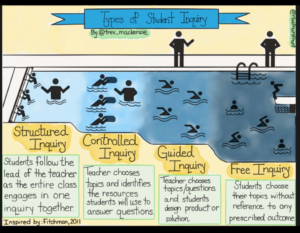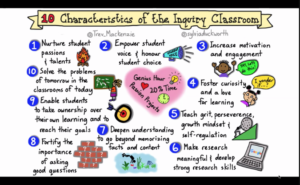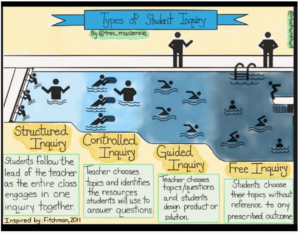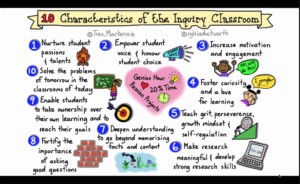Genius Hour (GH) is an educational movement that allows students increased freedom and creativity in their learning. This movement advocates for a learning environment where students are allocated 20% of their in-class time in order to private educational pursuits or projects that interest them (Genius Hour Website). This isn’t a concept that is simply limited to the classroom, as the Genius Hour website asserts that even companies such as Google offer their engineers 20% of their time to work on topics that interest them (Genius Hour Website). The theory here is that overall productivity and engagement are increased by allowing students (and workers) to spend a significant portion of their time on projects of passion and interest.
But how does this look in the classroom? In my opinion, GH could take form in multiple different ways in the classroom but the primary way that popped into my mind when considering GH were the different types of student inquiry and inquiry based learning.

(The Inquiry “pool”)
I think that that incorporating GH into teaching and the classroom would be most fluidly done if we consider the same process we would with the inquiry “pool”. Without proper scaffolding and preparation, I think that many students who dive right into the deep end with a Free Inquiry approach to GH will be lost and unsure as to how to approach effectively engaging with their topic and interests within this free educational context. When initially incorporating GH into the classroom, I would therefore advocate for a Structured Inquiry approach where the students follow the lead of the teacher while still pursuing their individual interests. This could look something like the teacher introducing a broad topic, such as movies, and from here have students research a movie of their preference. By starting with a more structured model of GH, students will have their learning scaffolded and have the ability to confidently move towards more independent models of inquiry during GH time. Having GH time structured into the classroom is absolutely a positive for student learning as long as it is structured in a way that fairly supports the learning needs of students.
Another positive of GH is that it has the potential to clearly outline expectations of students and allows them to prepare beforehand. If a student knows that 20% of their week will be composed of GH based inquiry learning, then they can dedicatedly enjoy working on their other subjects and classes all the while knowing that they will have opportunities throughout the week to study on subjects they are truly passionate about. This is not to say that GH should be used as an incentive or reward for working on other subjects (and I feel that if GH is misused, it is at risk of becoming so), but instead should be a means of intrinsically motivating students and fostering an truly engaging and wholesome classroom experience.
I believe that one potential con of GH is if it is overused in the classroom. For example, if a teacher sees that their students are enjoying their GH time so much that they decide to increase the amount of time dedicated to it to say 50 or 60%, then student learning in other areas of the curriculum will be heavily hampered. I feel as though this would be a relatively easy trap to fall into as a teacher, as what makes us happier than seeing our students happy? But we as educators need to realize that it is in our students’ best interest for us to limit GH time to 20% so that students can explore their interests while also being creative in a way that also promotes learning in other areas. One other potential con or risk is that students who are unfamiliar with an inquiry approach to learning might have some difficulties acclimating to this alternative approach to education. I, however, feel as though this is less of a difficulty and more of an opportunity for us as teachers to help aid these students in becoming more comfortable with inquiry based learning.

If implemented correctly, a classroom that incorporates GH can allow its students to develop the incredible skills included in the graphic above. And when GH learning is combined with these skills, students can experience a truly meaningful and fulfilling education.
Morgan’s section
Genius hour involves inquiry based, student led learning.
One way of incorporating Genius Hour into the classroom is allowing students to pursue passion projects. In this type of inquiry-based educational structure, students’ learning unfolds through the investigation of a central question or interest. The student is given a great deal of autonomy over their learning; they choose what they study, how they study it, and what they want to produce as evidence of their learning. Overall, the student is given freedom within the structure of genius hour.
The teacher’s role in this approach to learning is to be a guide for students and assist as needed. Before diving straight into implementing genius hour, the teacher and students can co-create a framework that outlines what a genius hour session period looks like (what are appropriate behaviours for students to engage in? How can they use the time effectively? What are different methods of effective research? etc.). This framework includes ground rules and ensures that the whole class understands the expectations. It is also something for students to fall back on if they get ‘stuck’ and don’t know what to do. The other important job for the teacher is to promote student centred learning and problem solving. Conferencing with students, coaching them through challenges, and helping them reflect throughout the process are all important behaviours for the teacher to engage in.
So, you want to try implementing genius hour? Great! This blog here ( https://www.cultofpedagogy.com/genius-hour-questions/ ) outlines the following step by step format of how to run a genius hour in your classroom.
- Planning: First, the teacher must plan out the time in the day that will be designated for genius hour. The blog suggests allotting 1 hour per day or 1 full class period a week for a set amount of weeks, depending on your unique classroom schedule. This step also involves the co-creation of a framework and ground rules with the students.
- Topic selection: Students do some preliminary research and choose what topic they would like to investigate and what they might produce at the end of the inquiry to showcase their learning.
- The Pitch: Each student assembles 4 slides and does a short presentation on 1. what they’re going to learn/make 2. why they’re going to learn it, why it’s important to them 3. how they’re going to go about it ie. A brief schedule of their assignment 4. what would success at the end of this look like for them?
- Research, learning and documentation: The teacher may do a short pre-teaching lesson on how to conduct proper research. Students will go to library, use quality online research engines, talk to experts, and document learning on a website, blog,journal, book, art, videos on youtube, a podcast, or any other method deemed appropriate.
- Making: During this step, the students will assemble their final piece. This is the making, creating, designing phase that makes their project a reality. It is important to have a class discussion around growth mindset and that challenges arise on the road toward success.
- The final stage, students present their learning!
If you are working to implement genius hour into a primary classroom, here are some things to keep in mind:
- Younger students need more structure. If you know student interests, perhaps have students go in groups to study one topic that interests them all, or do a whole class inquiry into a topic (this way you can offer more guidance)
- Talk about wonderings.. what do we want to learn, what are we interested about? They can look at books and videos for ideas
- Research may look different: you can have young students watch videos, have a guest speaker, or read a book together as a class
- The purpose and end products will look different for younger students!
- Narrow ideas down into a central question
- Use a set research plan – you create the plan and the students follow it
Follow this link for some great graphics and info on genius hour in the primary classroom
https://theteacherbag.com/awakening-the-genius-in-you-primary-classroom-genius-hour/
References:
Trevor McKenzie (Inquiry Pool + 10 Characteristics of Inquiry)
Genius Hour Website: https://geniushour.com/what-is-genius-hour/




